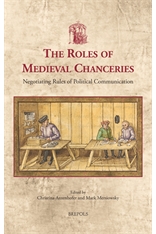The Roles of Medieval Chanceries: Negotiating rules of Political Communication, ed. Christina Antenhofer and Mark Mersiowsky (Turnhout, 2021: USML 51), x+199 pp. ISBN 978-2-503-58964-0
Medieval (political) communication followed rules that were defined, negotiated, and altered in processes of exchange. Conflicts resulting from different communication practices, as well as forms of innovation, revolve around rules that are not self-evident. Political actors such as princes and cities, chanceries, secretaries, ambassadors, and councillors formed rules of political participation, which became visible in written documentation. These rules were both formed and negotiated via processes of communication (a practice-oriented understanding of political participation). Medieval chanceries can thus be understood as a vast field of experimentation where different solutions were tested, passed on, or discarded.
This book explores communication practices in German, French, Italian, Tyrolian, and Gorizian chanceries, as well as at diets from the tenth to the sixteenth century. Its chapters examine royal, monastic, princely, and communal chanceries. For the early and high Middle Ages, a close analysis of documents will reconstruct negotiation and communication from within the documents themselves. For the later Middle Ages, focus will turn to the chancery, with the appearance of chancery orders and chancery annotations that provide explicit insight in communication between the chancellors, secretaries, and political authorities (princes or cities). The growing amount and variety of documents issued in the late Middle Ages allows us to retrace conflicts resulting from differing chancery practices as well as attempts to reorganise the chancery into a political instrument for the prince.
The processes of political communication are followed in three parts. Part I focuses on the rules within documents. Part II looks at administrative processes within specific chanceries, while Part III explores forms of exchange between the chancery and other political actors.
Contents:
Christina Antenhofer, “Introduction”
I. Rules Within the Documents: Chanceries and Charters
Sébastien Barret, “Perspectives for the Study of Sanctiones: Cluniac Examples from the tenth and Eleventh Centuries”
Arnold Otto, “Nulli … Si Quis and Their Copycats: Penal Forms in the Charters of Charles IV”
II. Chancery Rules and Organisation: The Chancery as Platform of Administration
Ellen Widder, “Internal Rules of Late Medieval German Chanceries and Their Heuristic Value”
Julia Hörmann-Thurn und Taxis, “Chancery Notations and Their Role as Means of Communication in Medieval Chanceries: The Case of the Bavarian and Tyrolean Chanceries”
Klaus Brandstätter †, “Late Medieval Urban Chanceries: Town Clerks and Town Books”
III. Platforms and Exchanges: Chanceries as Platforms of Political Communication
Isabella Lazzarini, “Power Beyond the Rules: Formalism and Experimentation in the Italian Chanceries (c. 1380–1500)”
Christina Antenhofer, “Antiquated Meets Modern: Conflicting Rules in Late Medieval Chancery Practices – The Example of the Gorizian Chancery”
Michaela Marini, “Vermerkt die gewalt, so in die cantzley geantwurt sind auf dem lanndtag […]: The Chancery and the Negotiations at the Tyrolean Diet, Fifteenth Century”
Index of Places and Personal Names
About the Authors


